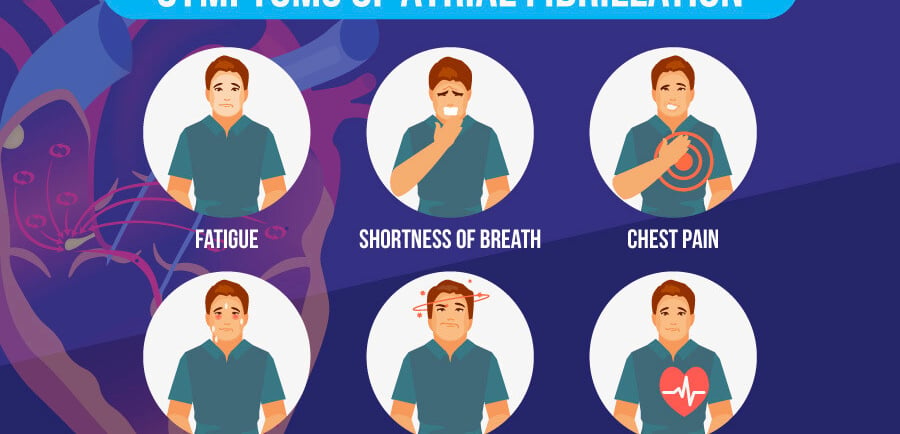A Great Way to Detect Warning Signs of Heart Fibrillation: Atrial Fibrillation (Afib) Screening for Early Diagnosis and Prevention
Blog post description.
7/24/20254 min read


Atrial fibrillation (AFib) is a common heart rhythm disorder that often goes unnoticed but significantly increases the risk of stroke and other complications. Detecting AFib early is crucial because many people experience no symptoms, making routine screening an effective way to catch warning signs before serious issues arise.
A reliable method to detect atrial fibrillation is through focused screening tests that monitor heart rhythm and identify irregularities early, even in asymptomatic individuals. These screenings can be done with simple, non-invasive tools and help guide timely medical intervention to reduce health risks.
By understanding the value of AFib screening, individuals and healthcare providers can work together to spot the condition earlier and manage it more effectively. This proactive approach is key to improving outcomes and preventing complications linked to this type of irregular heartbeat.
Understanding Atrial Fibrillation and the Importance of Early Detection
Atrial fibrillation (Afib) is a common heart rhythm disorder that can lead to serious health complications. Recognizing its signs, understanding associated risks, and taking advantage of early screening methods play crucial roles in managing and reducing its impact.
What Is Atrial Fibrillation (Afib)?
Afib is an irregular and often rapid heartbeat originating from the heart’s upper chambers (atria). This arrhythmia disrupts the coordinated contraction of the atria and ventricles, causing inefficient blood flow. It is the most common sustained cardiac arrhythmia worldwide.
The condition can be intermittent or persistent. Many people with Afib have no obvious symptoms, which contributes to delayed diagnosis. Older adults and those with certain health factors like hypertension or heart disease are at higher risk. Early detection relies on monitoring heart activity, often through electrocardiograms (ECGs) or wearable devices.
Common Warning Signs and Symptoms
Symptoms of Afib vary widely. Some individuals experience palpitations—a sensation of fluttering or rapid heartbeat. Others may feel lightheaded, dizzy, or short of breath. Fatigue and chest discomfort are also commonly reported.
However, many people with Afib are asymptomatic. This lack of symptoms makes regular monitoring important, especially for those with risk factors. Sudden worsening of symptoms or new-onset irregular heartbeat should prompt medical evaluation. Recognizing these signs early can prevent more serious complications. To Learn More Clink Link; http://llsa.go2cloud.org/aff_c?offer_id=2514&aff_id=2385
Risks Associated With Undetected Afib
Undiagnosed Afib significantly increases the risk of stroke. Blood pooling in the atria due to irregular contraction may form clots, which can travel to the brain. Afib also raises the risk of heart failure by reducing overall cardiac efficiency.
Other risks include cognitive decline and higher mortality rates. The longer Afib goes unnoticed or untreated, the greater the chance of complications. Stroke prevention through appropriate therapy hinges on timely diagnosis, emphasizing the need to detect Afib before it causes severe damage.
How Early Afib Screening Saves Lives
Early Afib detection allows prompt intervention to manage symptoms and prevent stroke. Screening methods include pulse checks, portable ECG devices, and mobile health technologies offering continuous heart rhythm monitoring.
Screening is especially recommended for adults over 65 or those with elevated stroke risk profiles. Confirming Afib typically requires ECG verification. Early treatment can involve blood thinners, rate or rhythm control medications, and lifestyle changes, all of which improve outcomes and quality of life. To Learn More Clink Link; http://llsa.go2cloud.org/aff_c?offer_id=2514&aff_id=2385
A Great Way to Detect Warning Signs of Heart Fibrillation: Afib Screening
Atrial fibrillation screening identifies irregular heart rhythms before symptoms worsen or complications like stroke occur. Various modern methods, clear guidelines on who should be screened, and preparation steps help make this process effective and accessible.
Modern Afib Screening Methods and Technologies
Screening for atrial fibrillation often begins with non-invasive tools that monitor heart rhythms. Traditional electrocardiograms (ECGs) remain standard, recording the heart’s electrical activity over short periods.
Wearable devices such as smartwatches and fitness trackers now provide continuous heart rhythm monitoring. These devices can alert users to irregularities, though their accuracy varies and they are not replacements for clinical diagnosis.
Portable monitors and patch devices offer extended monitoring, sometimes up to two weeks, increasing detection chances. These technologies detect intermittent AFib episodes that short ECGs might miss.
Screening often includes pulse checks and ambulatory ECG (Holter monitoring), focusing on identifying asymptomatic cases early.
Who Should Consider Afib Screening
People aged 65 or older are generally recommended for screening, given the increased AFib risk with age. Those with high blood pressure, heart disease, or a history of stroke are also prime candidates.
Individuals with symptoms like heart palpitations, dizziness, or unexplained fatigue should discuss screening with a healthcare provider.
Screening may be advised for people using wearable devices that report abnormal rhythms. However, doctors emphasize clinical evaluation to confirm the condition.
Those with risk factors such as obesity or diabetes should remain vigilant since these conditions increase AFib risk. To Learn More Clink Link; http://llsa.go2cloud.org/aff_c?offer_id=2514&aff_id=2385
Benefits of Routine Afib Screening
Early detection through screening can prevent stroke, as untreated atrial fibrillation substantially raises stroke risk. Timely diagnosis allows initiation of blood thinners and other treatments.
Routine screening helps identify asymptomatic individuals who might otherwise remain undiagnosed until complications arise.
It enables better management of heart rate and rhythm, reducing symptoms and improving quality of life.
Early treatment supported by screening can also decrease hospitalizations related to AFib complications.
Screening provides a clearer picture of patient risk and guides personalized treatment plans. To Learn More Clink Link; http://llsa.go2cloud.org/aff_c?offer_id=2514&aff_id=2385
How to Prepare for an Afib Screening
Before screening, patients should avoid caffeine and tobacco as these can affect heart rate.
Wearing loose clothing helps facilitate device placement for ECG or patch monitors.
Patients should bring records of any symptoms like palpitations, dizziness, or chest discomfort to inform the clinician.
It is helpful to list current medications, including supplements, as they can influence heart rhythm.
During longer monitoring, patients should maintain normal daily activities while logging any unusual symptoms.
Clear communication with the healthcare provider about concerns and symptoms improves screening accuracy and follow-up care.